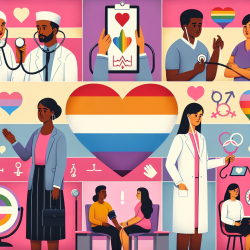Introduction
The healthcare landscape for transgender and gender diverse (TGD) individuals is evolving, yet significant gaps remain in meeting their comprehensive care needs. The research article "Integrated Comprehensive Care for Transcare and Gender Diverse Clinic Patients: An Assessment of Physical, Mental, and Social Needs" provides valuable insights into addressing these gaps. As practitioners, it's crucial to integrate these findings into practice to enhance care delivery and improve patient outcomes.
Understanding the Research Findings
The study conducted at the Nebraska Medicine Transgender Care Clinic (NMTCC) highlights the importance of integrated services that encompass physical, mental, and social care needs. The survey results indicate a high demand for gender-affirming surgeries, primary care, voice therapy, and mental health services among TGD patients. Additionally, there is a strong interest in participating in support groups and educational activities, which underscores the need for community-building initiatives.
Implementing Integrated Care Models
Practitioners can enhance their skills by adopting an integrated care model that centralizes services for TGD patients. This model should include:
- Comprehensive Clinical Services: Ensure access to primary care, hormone therapy, gender-affirming surgeries, and mental health support within a cohesive framework.
- Community Engagement: Facilitate support groups and educational workshops that foster a sense of community and provide valuable information on navigating healthcare and legal systems.
- Patient-Centered Approach: Engage directly with patients to gather feedback and tailor services to meet their unique needs, thereby building trust and improving health outcomes.
Addressing Challenges and Opportunities
While implementing integrated care models, practitioners may face challenges such as resource limitations and the need for specialized training. However, these challenges also present opportunities for innovation. Collaborating with organizations like TinyEYE, which provides online therapy services, can help bridge service gaps and extend care to underserved areas.
Encouraging Further Research
Ongoing research is vital to continually refine and improve care models for TGD patients. Practitioners are encouraged to participate in research initiatives, contribute to data collection, and stay informed about emerging trends and best practices in gender-affirming care.
Conclusion
By integrating the outcomes of the research into practice, practitioners can significantly improve the quality of care for TGD patients. This approach not only addresses immediate healthcare needs but also contributes to reducing health disparities and promoting equity within the healthcare system.
To read the original research paper, please follow this link: Integrated Comprehensive Care for Transcare and Gender Diverse Clinic Patients: An Assessment of Physical, Mental, and Social Needs.










